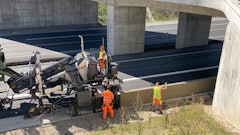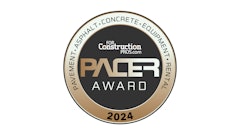
The American Concrete Pavement Association (ACPA) today offered a current view of the highway pavement sector, as well as a glimpse of factors affecting the market in the short term.
“Our current view is that the market has stabilized after years of economic decline,” said Gerald F. Voigt, P.E., ACPA President and CEO. “For many years, many public agencies have been deferring major capital improvement projects in favor of projects with shorter time frames.
“We have some midterm optimization due to our success in implementations of concrete overlay technology and research confirmations of long life pavement performance making it into the new design procedures; this is ensuring the confidence in more predictive pavement designs of the future and mitigating some of the ultra-conservative designs that were keeping concrete from participating in many rehabilitation, and in some cases, new alignment projects.
“Even though the Fast Act was passed in December 2015, agencies are still not delivering significant numbers of capital improvement projects. With that in mind, our estimates for 2017 indicate a market volume about level with our 2016 of over 50 million square yards of concrete paving nationwide.
“This figure applies mostly to mainline highway projects, and although we do not specifically track spending on airports, streets & roads, and industrial and commercial pavements, the highway figures are typically a good barometer of volume in other markets.
“Concrete pavement carries most of the heaviest loads in this nation, and with the current focus on global competitiveness and the role infrastructure plays in industry and commerce, we support the emphasis on freight movement in our great nation,” Voigt said.
He cited a provision in MAP 21 that offers some encouragement. “With MAP 21 spelling out the National Highway freight network, we are encouraged because concrete makes highway movement of freight possible – we can carry the load on our back – as we have for several years. With that premise, and from a rehabilitation standpoint, we have been able to offer some excellent solutions for agencies with our concrete overlay strategy.
Concrete Overlays Bolster Market
“Concrete overlays usage has increased steadily for 10 years straight, and in the past three years, concrete overlays have accounted for more than 15 percent of the overall concrete pavement volume nationwide,” Voigt said.
“Concrete overlay technology development, as well as implementation and education by ACPA, ACPA-affiliated Chapters and State paving associations, and the National Concrete Pavement Technology Center (CP Tech Center), have been instrumental in this growth,” Voigt said, adding that some of this work has also been done in partnership with the Federal Highway Administration, which has contributed funds to the technology transfer efforts.”
Short-Term Outlook
“Looking ahead, we are encouraged that infrastructure investment and jobs creation appear to be a focal point for the new Administration,” he said, adding well-paying jobs is a tangible benefit of infrastructure development.
"What remains to be seen are the answers to funding questions, and it will be critical to understand exactly how infrastructure investment is defined in the months ahead. We are working to help identify those mechanisms to ensure investments for the Federal-Aid Highway and Airport program. We support tax reforms being a part of the fix of the Highway trust fund.
Voigt expressed cautious optimism that the narrative in Washington, D.C., is changing, adding, “We are hopeful that the focus and interest in infrastructure investment continues to be strong in the months and years ahead.
“We were encouraged by comments from Elaine Chao during her recent confirmation hearing, notably that she thinks President-elect Donald Trump's $1 trillion infrastructure vision will contain at least some direct federal spending; that she anticipates a high priority for the Department of Transportation will be to find a way to patch the Highway Trust Fund; and that one of her first orders of business will be to create an infrastructure task force.
“There are still many details that need to be worked out, but a key to the infrastructure plan, especially for the surface transportation elements, will be funding. ACPA also supports the development of a new funding mechanism for the highway and road network. It is clear that the current funding model for the Highway Trust Fund (HTF) is falling short.
“The United States cannot continue to use non-indexed gasoline and diesel taxes to generate the HTF revenues, as the funding challenge compounds with increasing use and associated wear and tear of the system,” Voigt said. “An increase in the gas tax—a user fee—is necessary in the short term, but our national policy must move toward a system, such as vehicle miles traveled (or VMT) that more directly aligns fees charged with the benefits derived by the user.
“Our industry believes that fixing the insolvency of the highway trust fund must be part of any federal tax reform package. We are presently evaluating multiple proposals to take to the new administration,” Voigt added.





![[VIDEO] Lori Tiefenthaler, Chair of the ACPA focuses on diversity and a new program](https://img.forconstructionpros.com/files/base/acbm/fcp/image/2017/01/default.587ec0a0edf57.png?auto=format%2Ccompress&fit=crop&h=167&q=70&w=250)
![[VIDEO] Telex Bid-Well’s new remote control feature at World of Concrete 2017](https://img.forconstructionpros.com/files/base/acbm/fcp/image/2017/01/default.587ec8a6e30da.png?auto=format%2Ccompress&fit=crop&h=167&q=70&w=250)












